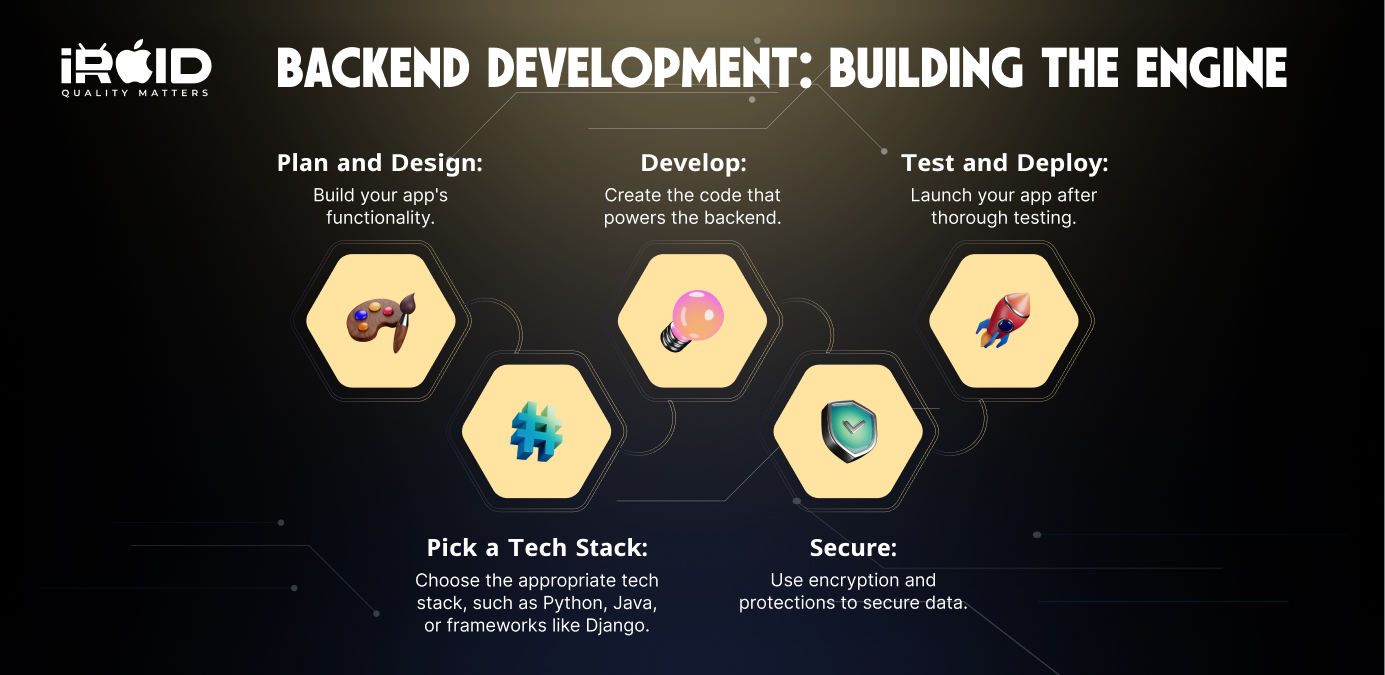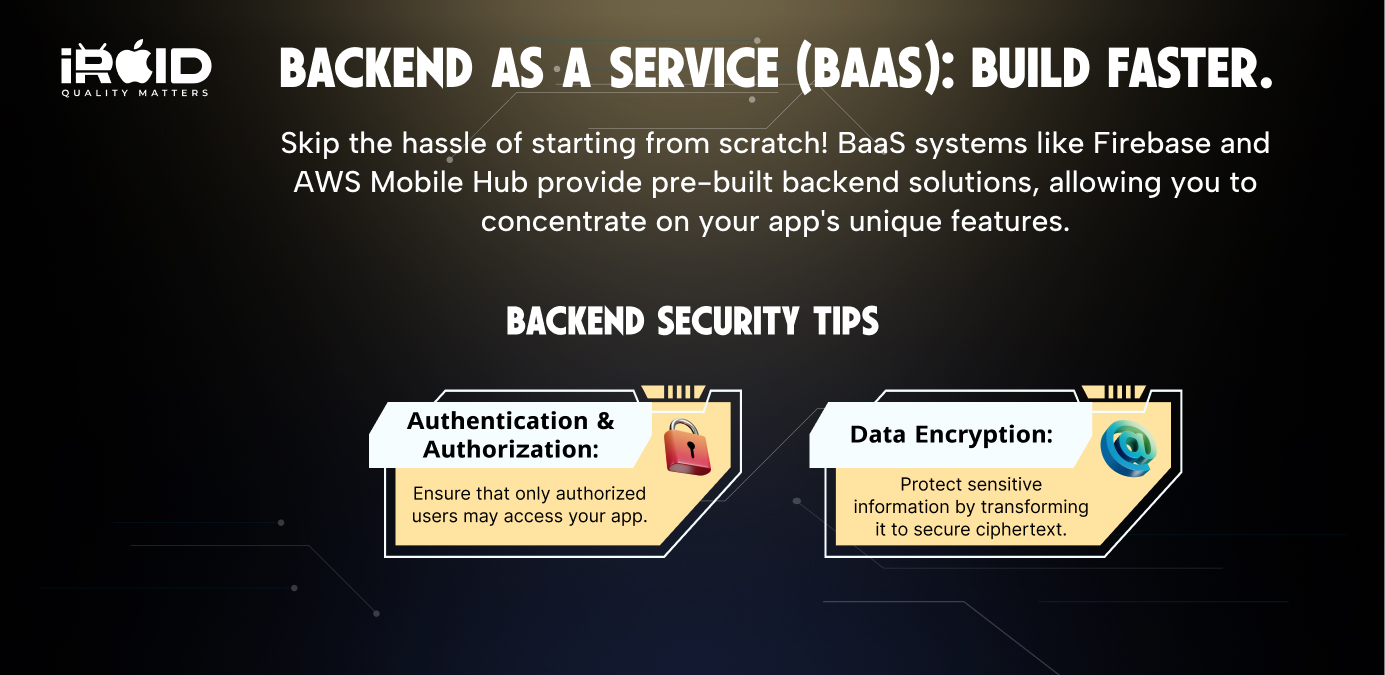Mobile App Backend Development4: The Secret Powerhouse Behind Your App
Imagine a mobile app as a shiny new car. It looks great, has a sleek interface (the dashboard), and lets you do cool things (the features). But what makes the car run? That's the engine – the hidden part that does all the hard work. In the world of mobile apps, the engine is the backend.
What is a mobile app backend?
Think of it as the app's control centre. It runs on a remote server and silently handles all the critical tasks that make the app function:
-
Data storage: The backend is like a giant filing cabinet for your app's data. This could be anything from user profiles and shopping lists to game scores and chat messages.
-
Security: The backend acts as a guard, keeping your app's data safe from unauthorized access. It uses encryption to scramble information and makes sure only authorized users can see what they're supposed to.
-
Business Logic: This is the brain of the app. The backend defines the rules and processes that make things happen. For example, it might determine how points are awarded in a game or how discounts are calculated in a shopping app.
Why is a backend so important?
Without a backend, your app would be pretty limited. It wouldn't be able to store any data, so forget about remembering login information or saving progress. Security would also be a nightmare, making your app vulnerable to attacks. The backend is what gives your app the power to be truly functional and engaging.
The Core Components: Building the Engine
Now that you know what the backend does, let's explore the parts that make it tick:
- Databases: These are the filing cabinets we mentioned earlier. There are two main types:
- SQL databases: Imagine a tidy filing system with labelled folders and clear organization. That's SQL, perfect for storing structured data like user accounts or product information.
- NoSQL databases: Think of a big box where you can toss things in without worrying about specific categories. NoSQL is ideal for unstructured data like social media posts or chat messages.
- Servers: These are the computers that run the backend software. You can choose between:
- Cloud servers: Like renting office space in the digital world, you access powerful servers via the internet (cloud). It's cost-effective and scalable (you can add more power as needed).
- On-premise servers: Owning your own server is like having a physical office for your app's data. It offers more control but requires more maintenance and upfront investment.
- APIs (Application Programming Interfaces): Imagine a waiter taking your order and delivering it to the kitchen. APIs act as middlemen, allowing the mobile app (the customer) to communicate with the backend (the kitchen) and request or send data.
The Backend Development Process: How the Engine Gets Built
Building a backend is like building a car engine – it requires careful planning and the right tools:
-
Planning and Architecture Design: This is like drawing the blueprint for the engine. Here, you define the app's functionalities and choose the technologies that will power it.
-
Choosing the Tech Stack: This is your toolbox. You'll need to select programming languages (like Python or Java) and frameworks (like Django or Spring) that are suited to your app's needs.
-
Development: Time to start assembling the engine! Developers write code to bring the backend to life, implementing the planned functionalities.
-
Security Implementation: Security is like installing an alarm system for your engine. This involves encrypting data and putting measures in place to prevent unauthorised access.
-
Testing and Deployment: Just like you test drive a car, the backend goes through rigorous testing to ensure everything works smoothly. Once it passes the tests, it's deployed and your app is ready to hit the road (or rather, the app store)!
Backend as a Service (BaaS): A Shortcut for Busy Builders
Building a backend from scratch can be time-consuming. BaaS comes to the rescue! Think of it like buying a pre-built engine for your car. BaaS providers like Firebase or AWS Mobile Hub offer ready-made backend functionalities that you can easily integrate with your app. This saves development time and allows you to focus on the unique features of your app.
Security Best Practices: Keeping Your Engine Safe
Just like a car needs regular maintenance, your app's backend needs robust security measures:
-
User Authentication and Authorization: Make sure only authorised users can access your app's data. This involves implementing login systems and defining user permissions.
-
Data Encryption: Data encryption converts plain text into ciphertext, using algorithms and keys, to ensure confidentiality and security during transmission or storage. It prevents unauthorised access and protects sensitive information from being read by unauthorised parties.
Conclusion:
In conclusion, the backend serves as the powerhouse of your mobile app, handling critical tasks like data storage, security, and business logic. Without it, your app would lack functionality and security, limiting its potential. At iRoid Solutions, we specialise in building robust and secure backends tailored to your app's needs. Contact us today to unleash the full potential of your mobile app!
Blog Related FAQs:
Mobile app backend development involves creating the server-side components that handle data storage, security, business logic, and communication between the app and the server. It ensures the app operates smoothly and securely.
A backend is essential for storing user data, managing business logic, ensuring security, and enabling features like login, notifications, and seamless communication between users or devices.
Common technologies include programming languages like Python, Java, and PHP, frameworks like Node.js, Django, and Laravel, and databases like MySQL and MongoDB.
SQL databases store structured data in tables with predefined schemas, ideal for organized data like user accounts. NoSQL databases handle unstructured data like social media posts and are more flexible.
BaaS provides pre-built backend functionalities, such as Firebase or AWS Mobile Hub, allowing faster development by eliminating the need to build a backend from scratch.
Costs vary depending on app complexity, technology stack, and developer expertise. Reach out for a custom quote based on your app's needs.
Recent Blog Posts
Get in Touch With Us
If you are looking for a solid partner for your projects, send us an email. We'd love to talk to you!
















